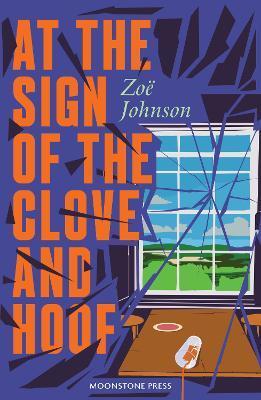At The Sign Of The Clove And Hoof

A review of At The Sign of the Clove and Hoof by Zo ë Johnson
And now for something completely different. If you like your crime fiction somewhat leftfield and laced with humour then At The Sign of the Clove and Hoof, originally published in 1937 and recently reissued by Moonstone Press is one you should definitely seek out. Zoë Johnson is a new author to me, and it is probably not surprising as she seems to have only published two books, this and Mourning After which came out in 1938 and is as rare as hen’s teeth.
This book is patchy and as is often the way it starts off well and then sags a little bit in the middle before recovering its joie de vivre for an astonishing ending, which I did not see coming. The action is set in Larcombe, an out of the way village in coastal Devon, populated by a wide range of eccentric characters who congregate at the local pub by the name of The Clove and Hoof to swap stories or, when he is in port, listen to the yarns of the local seafarer, Captain John Thomas Ridd, a larger-than-life character complete with obligatory wooden leg. Johnson is in her element lacing her introductions to the village and the assortment of oddballs with much humour and although they are stereotypical, they long remain in the memory.
For such a quiet village, there is an astonishingly high body count as first the vicar is found shot dead at the bottom of a cliff near where his car is parked and then the decapitated body of a stranger, claiming to be a detective from Scotland Yard, is found. His head surfaces in front of a couple of lovers canoodling by the village pond. Next to go is the eccentric, unhinged recluse, Gedling, who has been the victim of a series of practical jokes including finding a dead fish put in his bed and being plagued by a metronome. Then the good Captain Ridd disappears, presumed dead, and mine host of The Clove and Hoof, Yeo, is poisoned by gas, presumed to be suicide as he has been spooked by the recent goings-on in the village. The sixth death sand then the bluff antiquarian and jack-of-all-trades all meet their maker inside 200 pages. Not all are murders but all are connected.
The police investigations are led by two officers with widely differing characters and approaches. The local officer, Inspector Blutton, is officious and his abrupt manner gets the backs up of the locals. He is quick to infer that Ridd, the only one-legged man in the village, is the culprit from the footprints of a large hobnailed boot and the tip of a wooden leg found near the vicar’s car.
Blutton is irked by the arrival of the ridiculously moustachioed Sergeant Plumper of the Yard. Younger and with a more sympathetic approach, he strikes up liaisons with Peascod, an artist and newcomer to the village whose metronome was found in Gedling’s house and handkerchief in the rifled study of the vicar’s home, and an eager newshound who pens features for the wonderfully named Sunday Emetic.
Plumper violently disagrees with Blutton’s analysis of the events, especially as it does not fit with all the known movements of the suspects, and looks for a more subtle motivation, hitting on blackmail consequent upon the drunken romantic liaisons of the vicar and Gedling. His investigations leads him to some amusing encounters with a gin-sodden landlady in London who has more than a tale or two to tell.
However, both are off beam and the real story behind the crime spree only emerges when the culprit gives a long and detail confession while holding Plumper hostage in a cave. Purists will shake their heads in dismay that Johnson has resorted to this mechanism to bring her tale to a conclusion, but I feel that would be misinterpreting the book.
I see it not as a piece of crime fiction but as a satire of the genre, poking fun at suspects by exaggerating their ridiculous characteristics and the investigators by ridiculing their quickness to grasp a theory and their reluctance to let go. That the truth behind the deaths was missed by all and that the reader had little chance of gaining the satisfaction of getting there before the sleuths is all part of her send up of the conventions of the genre. Even the dearth of female characters, the few that there are all assume menial roles, is not a weakness but a reflection of the male domination of crime fiction.
Seen in the that light it is a minor masterpiece.



